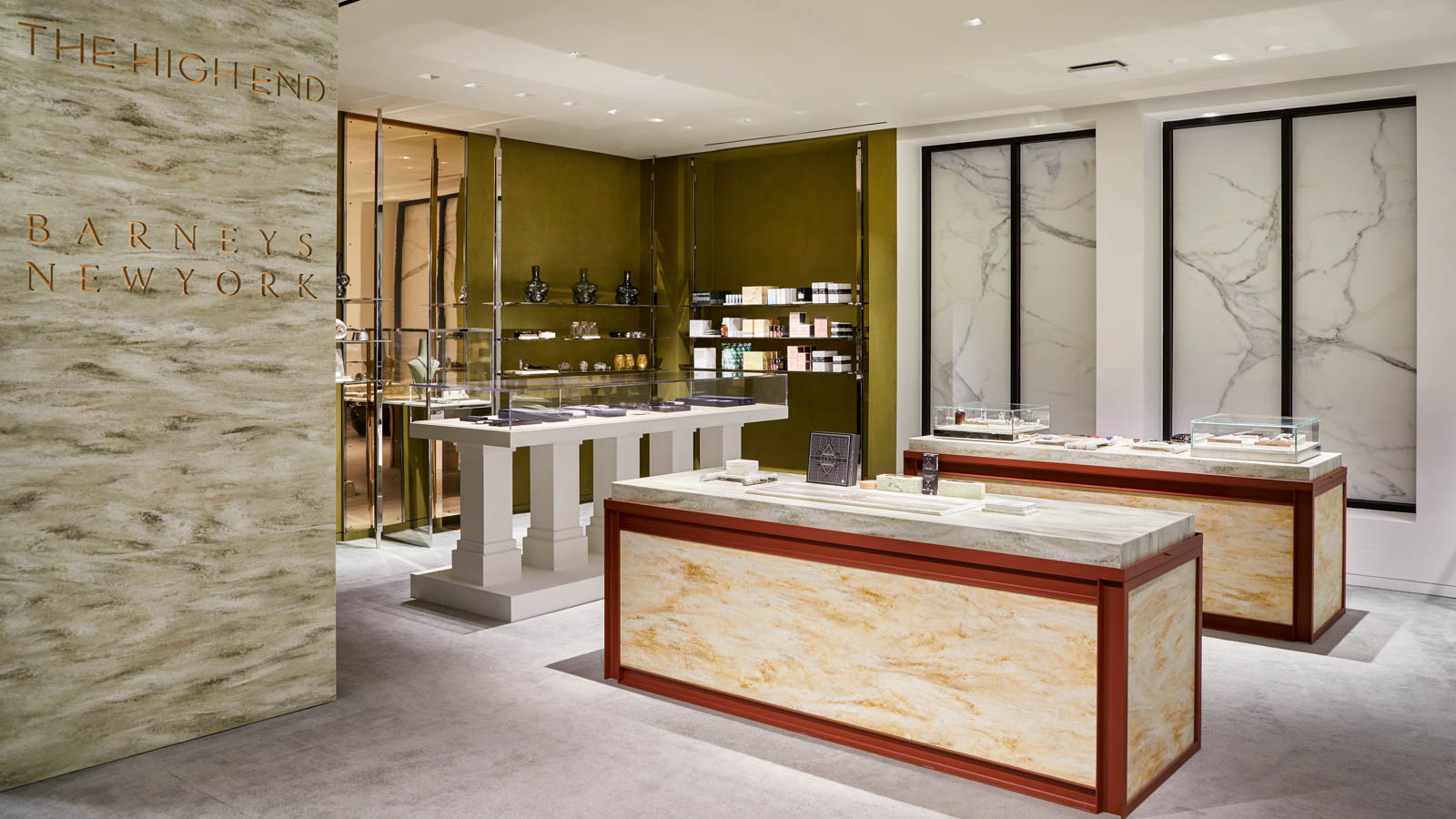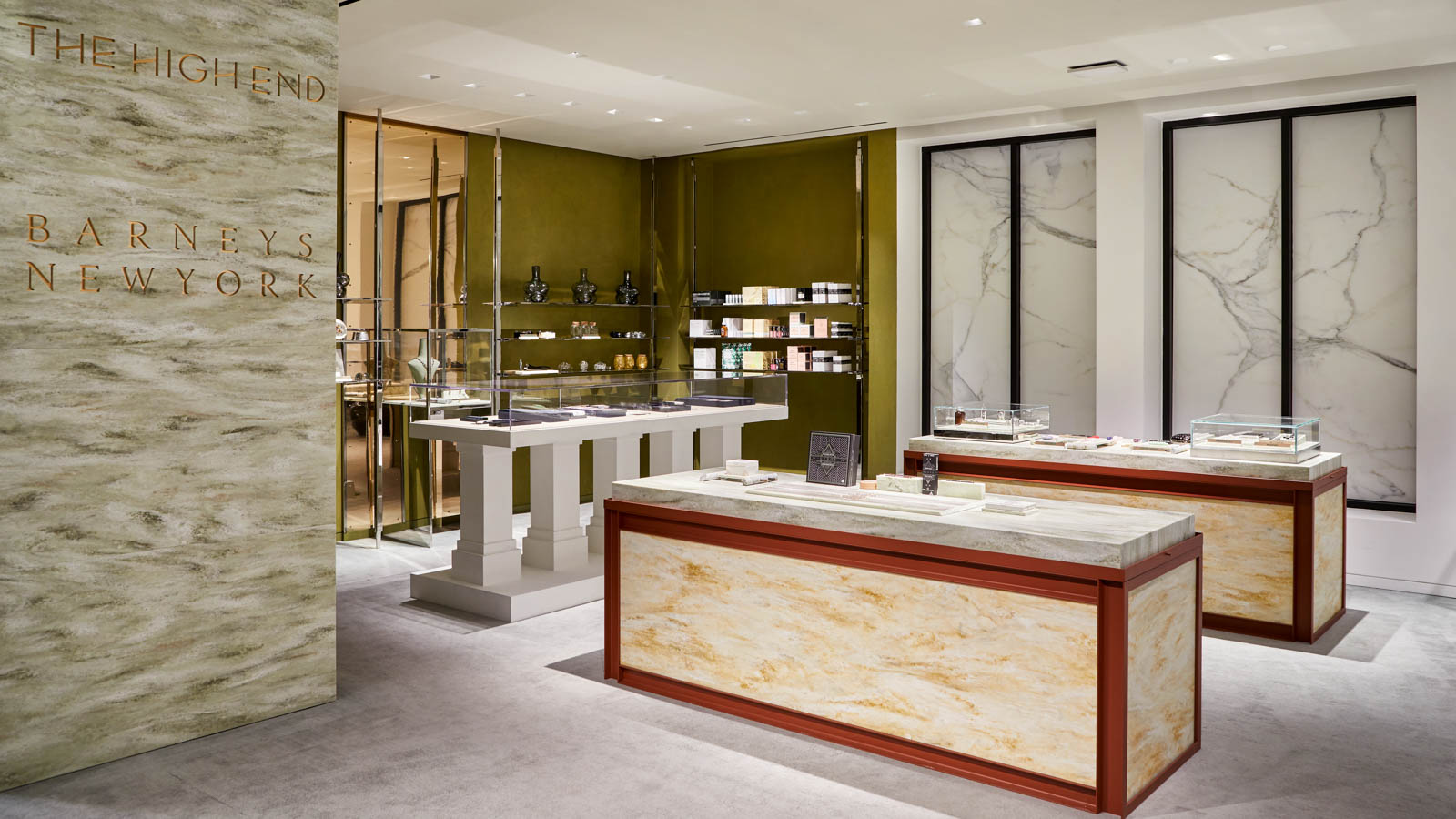
The luxury department store Barneys New York opened a cannabis lifestyle shop in its Beverly Hills location in March 2019. Weedmaps News sent columnist Lindsey MaHarry to review the custom luxury space.
On the fifth and top floor of Barneys New York in Beverly Hills, California, is a desolate place with an empty mirrored restaurant that leads to circular shelves of marked-down men’s footwear. Past all of that, nestled as far away from any relevant section of the store as possible, is a chartreuse enclave known as High End, the luxury retailer’s foray into the world of weed.
The aptly named lifestyle shop is a bold move for a company who’s spent the last century catering to the material whims of the world’s richest people. While the existence of High End is indicative of the major shift legality has brought to the public’s perception of cannabis, Barneys overly cautious execution feels self-conscious, the merchandise contrived.
While it’s pretty cool there’s a weed shop in Barneys, High End also functions as a reminder not to confuse corporate America’s enthusiasm for making money off cannabis with an actual understanding of the culture itself.
With no signage outside, shoppers must catch High End etched in black letters on a translucent glass case to even know the department is there. The space is discrete and intentionally understated. Products are displayed about the mid-century-modern-style room in glass cases, on marble tables, or on metal shelves.
The High End at the Beverly Hills, California, location of high-end department store carries big-ticket marijuana accessories. It does not sell any actual weed, however. (Photo courtesy of Barneys New York)
Because High End doesn’t have a state or local license to sell cannabis, they’ve partnered with Beboe, the cannabis brand to the stars once dubbed by The New York Times as the “Hermès of Marijuana”, founded by celebrity tattoo artist Scott Campbell and former fashion executive Clement Kwan. Customers can browse dummy Beboe products (there is no THC on site, so the packages are empty), order in the store on an iPad, then receive their purchase at home in about a half-hour through Beboe’s partner delivery service, Emjay.
As Beboe is the only consumable cannabis brand available for purchase, High End takes the concept of “cannabis lifestyle” products to a whole other level, sparing no expense in redefining the boundaries of the term.
There’s the $625 case for a mini Bic lighter. And the Tuileries Pre-Rolled Paper Cone Set, so someone who doesn’t know how to roll a joint can pay $80 for six empty pre-rolled hemp rolling papers. And a $920 ashtray made from chrome-plated brass and the horn of an African bull. A $1,250 necklace to hold a $30 Pax vape. And a number of $400 twisted glass pipes that look like something a street vendor would hawk on Hollywood Boulevard for much less than $400.
The Vintage Hermès ashtrays were beautiful, though. So were the thousand-dollar stash boxes. The $7,000 weed leaf stud earrings, however, were not. Nor was the massive silver-and-gold link chain featuring a diamond-encrusted medallion with an upside-down weed leaf that read “Lighten Up.”
The only constant in this cacophony of impossibly priced items — where weed products like bongs and grinders are paired with $600 coke vials, Juul holders, and $5,000 speakers — seems to be a complete lack of understanding of what actually constitutes weed culture. Why are Juul holders, $5,000 speakers, and coke vials being sold at a cannabis pop-up? Who spends $700 on a lighter case when every stoner knows lighters come and go like the wind? Why would someone ever spend $80 on six rolling papers when they don’t even know how to roll a joint?
New Money, New Weed
The answer is, of course, rich people want to be cool. Could be that a guy waiting for his Maserati at the Catch valet stand wants to impress others by hitting an expensive vape. Or maybe a hapless internet dater with a disposable income is trying to figure out what “420-friendly” means on someone’s dating profile. Might be a techie who just invested six figures into a weed company and wants to play the part.
As legalization spreads and there is an explosion in new cannabis users, that means there is an explosion in new money, too.
But it’s not that easy to jump into weed culture. To truly know what you’re doing, you have to have been smoking for years. In Los Angeles, where appearances can be valued over substance, those who can afford it would rather pay to partake in a trend than spend a couple of hours learning how to roll a joint or researching the science behind the endocannabinoid system.
In the market for $7,000 earrings in the shape of marijuana leaves? How about a $920 ashtray made of an African bull horn and brass plated in chrome? Barneys New York has it in its High End section in its store in Beverly Hills, California. (Photo courtesy of Barneys New York)
According to High End’s website, Barneys CEO Daniella Vitale wrote, “Barneys New York has always been at the forefront of shifts in culture and lifestyle, and cannabis is no exception. Many of our customers have made cannabis a part of their lifestyle, and High End caters to their needs with extraordinary products and the service they experience in every facet of Barneys New York.”
Vitale may be right in that many of their customers have recently made cannabis a part of their lifestyle and will want the expensive accessories to prove it, but to say that Barneys has been at the forefront of shifts in culture is simply false.
The retailer exists on the forefront of cultural appropriation in fashion. Fashion draws on subcultures and countercultural movements by reproducing their aesthetic, charging prices few purveyors of culture could ever afford, then selling it to the masses as a trend. It happened to psych rock. It happened to punk. It happened to hip hop. Now it’s happening to cannabis.
Barneys, Don’t Be Nervous. It’s Just Weed.
With the lack of actual weed brands (read: with cannabis products to, you know, consume) in its hidden location and strange assortment of products that lump cannabis in with vogue substances (read: cocaine, Juul) there’s a fundamental break in the concept’s execution. They are playing both sides, pretending to be hip with cannabis, but more concerned with not offending it’s typical clientele (read: rich people who think they’re in “Sex and the City”).
Everything about High End feels nervous, like a kid on the playground lying to be cool, hoping his mom doesn’t find out later. Floor staff aren’t allowed to answer simple questions about the store to the media; everything must be directed to Barneys corporate PR representative.
The excessively material culture that Barneys represents is the antithesis of weed culture.
But hey, it happens. Everything that is considered cool gets co-opted at one point or another, that’s kind of the point. Cannabis helps people, and should never have been demonized. Barneys might not be for stoners or anyone who values the history and culture of weed, but at least it’s helping to lift a stigma that’s stifled decades of medicinal research and incarcerated so many.











